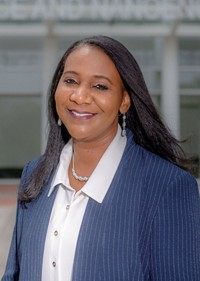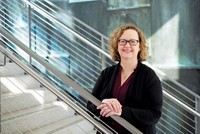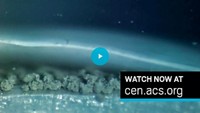×
CEN's 2020 Trailblazers
Paula Hammond: Drug delivery pioneer
Oluwatoyin "Toyin" Asojo: Rare-disease drug hunter
Laura Dassama: Sickle cell fighter
Cordell Hardy: Industrial innovator
Vernon Morris: Atmosphere investigator
Isiah Warner: Materials maestro and mentor
Malika Jeffries-EL: Semiconductor materials maven
Squire Booker: Catalysis champion
Jamel Ali & Patrick Ymele-Leki: Biofilm-busting duo
Carl Bonner: Jack of all chemistries
Cato Laurencin: Tissue regenerator
Kristala Prather: Synthesis warrior
Samson Jenekhe: Polymer powerhouse
Davita Watkins: Supramolecular chemistry sleuth
Karen Akinsanya: Strategic drug discoverer
Lynden Archer: Entrepreneurial educator
Etosha Cave: CO2 converter
Kimberly Jackson: Cancer slayer
Thomas Epps & LaShanda Korley: Upcycling champions
Sherine Obare: Interdisciplinary icon
Historical profiles
Contributors
C&EN's 2020 Trailblazers Celebrating badass women entrepreneurs in chemistry
Advertisement
Grab your lab coat. Let's get started
Welcome!
Welcome!
Create an account below to get 6 C&EN articles per month, receive newsletters and more - all free.
It seems this is your first time logging in online. Please enter the following information to continue.
As an ACS member you automatically get access to this site. All we need is few more details to create your reading experience.
Not you? Sign in with a different account.
Not you? Sign in with a different account.
ERROR 1
ERROR 1
ERROR 2
ERROR 2
ERROR 2
ERROR 2
ERROR 2
Password and Confirm password must match.
If you have an ACS member number, please enter it here so we can link this account to your membership. (optional)
ERROR 2
ACS values your privacy. By submitting your information, you are gaining access to C&EN and subscribing to our weekly newsletter. We use the information you provide to make your reading experience better, and we will never sell your data to third party members.
Nanomaterials
Movers And Shakers
One on one with Lynden Archer
Postdoc Simone Douglas-Green talks to this chemical engineer and entrepreneur about the serendipity of opportunity
by Simone A. Douglas-Green, special to C&EN
February 22, 2021
| A version of this story appeared in
Volume 99, Issue 6
Lynden Archer is known for his work with “hairy” nanoparticles. He studies structure, dynamics, and transport at liquid-solid interfaces using polymer and hybrid materials with applications in energy storage technologies. He cofounded NOHMs Technologies to commercialize novel battery materials developed in his Cornell University lab. NOHMs, which stands for nanoscale organic hybrid materials, was named one of C&EN’s 10 Start-Ups to Watch in 2015. Archer is a member of the National Academy of Engineering and a fellow of the American Physical Society. Simone A. Douglas-Green spoke with Archer about how he chose his research focus and what it takes to start a successful company. This interview has been edited for length and clarity.

Credit: Courtesy of Lynden Archer
Lynden Archer
Lynden Archer
Hometown: Georgetown, Guyana
Education: BS, University of Southern California, 1989; MS, 1990, and PhD, 1993, Stanford University
Current position: Joseph Silbert Dean of Engineering and James A. Friend Family Distinguished Professor in Engineering, Cornell University
Fun project he’s been working on: I’ve learned to grow eggplants of all varieties—this is hard. I also discovered the New York Times Cooking website and have been on a virtual world tour of eggplant varieties and recipes.
Best professional advice he’s received: Closed doors provide direction.
Simone Douglas-Green: When was the moment you felt like a real scientist?
Lynden Archer: I was about 9 or 10 years old. My mom bought me a science book, and one of the chapters extolled the wonders of brewer’s yeast, which affects metabolism. My mom was entrepreneurial and raised broiler chickens as an income supplement, and she allowed me to experiment with metabolism by adding brewer’s yeast to a small portion of her flock. I had some chickens as controls even though I didn’t know what controls were at the time. I felt like a real scientist using the essential tools of science and discovery to answer a question, and that ultimately gave me more confidence.
SDG: As an aspiring professor, I am trying to figure out what the research focus of the Douglas-Green lab would look like one day. How did you figure out the research focus of the Archer Research Group?
LA: I think this is something aspiring professors stress themselves out too much over—the thought of coming out on day 1 with a career-defining research direction that they’re going to follow faithfully throughout a career. An essential part of growing and becoming successful as a scientist is understanding your core skill set and the things that excite you and working to develop those fully. Successful professors must be able to see change coming and have the tools ready to adapt. That means you’re reading the literature, you’re sitting in talks at conferences that aren’t in your area, and you’re hearing what other communities are thinking. The graduate student and postdoc years are excellent times to identify and burnish these core skills.
SDG: This is fantastic advice to hear, especially as a new postdoc in a chemical engineering lab coming from a biomedical engineering background looking to expand my skill set in drug delivery design. Can you talk about the design process of your nanoparticles?
LA: It occurred to me that if one can make hairy nanoparticles that are uniformly covered with an oligomer, it should be possible to create new types of inorganic-organic hybrid materials. We discovered that if you inspected one family of the materials in an electron microscope, they look like sand, but if you observed them with the naked eye, they look like a viscous fluid. I later wrote a National Science Foundation proposal hypothesizing that an entire class of functional inorganic-organic hybrid materials can be created from the basic building blocks, but at the time I had no idea what function would emerge as useful. The connection with electrical energy storage in metal-anode batteries (Adv. Mater. 2013, DOI: 10.1002/adma.201303070 and Nat. Energy 2016, DOI: 10.1038/nenergy.2016.114), which now forms about 75% of the research in my group, emerged completely by accident after listening to a talk by a colleague working on block copolymer electrolytes for safe batteries. The lesson here is that you need to be prepared, but there’s also the serendipity of opportunity. If there wasn’t a need for a function in the NSF program directive, I would have likely continued studying only the fundamental aspects, perhaps with more limited impact.
SDG: Do you remember a key experiment that led to some remarkable discoveries?
LA: In polymer science, there’s a well-worn principle known as time-temperature superposition, wherein studies of a material’s response over a small period of time and at a range of temperatures are used to infer a response over a large range of time at a fixed temperature. We discovered that by applying strain (instead of temperature) to our hairy nanoparticles, it is possible to use measurements of their dynamic responses on timescales on the order of seconds to infer dynamical behaviors on extraordinarily large timescales (Nano Lett. 2009, DOI: 10.1021/nl9029847). We still don’t know fundamentally where this characteristic originates, but we know that it is related to an unjamming transition produced by strain and that it is commonplace in these hybrid materials.
Successful professors must be able to see change coming and have the tools to adapt.
SDG: You cofounded NOHMs Technologies. How did you take your research on energy storage and batteries from benchtop to developing a company?
LA: I think it requires a culture in which students and postdocs who carry out the studies have an interest in commercializing their work. One postdoc made a major discovery related to sulfur (Angew. Chem., Int. Ed. 2011, DOI: 10.1002/anie.201100637), and there was interest in commercializing this. We filed a patent, formed the company with the postdoc as the first employee, and the company grew. A successful company is less about the product and more about the nimbleness of the people to redesign and reconfigure that product to meet current market needs. We started with this idea of making rechargeable batteries based on exceptional cathodes that would measurably improve cell-level energy density relative to today’s lithium-ion technology, and the market was not ready for that. The market was still focused on improvements to lithium-ion technology. The NOHMs technical team discovered that an analogous hybrid platform (Angew. Chem., Int. Ed. 2010, DOI: 10.1002/anie.201004551) based on ionic liquid chemistry could be leveraged to create powerful additives for tuning important electrolyte characteristics (e.g., flammability) in today’s lithium-ion batteries.
LA: I’ve done a bit of research on your background, too. It is clear that you’re on quite a strong trajectory. If you were attempting to leverage success diversifying the undergrad student body to grad students and faculty, what are some tips you would offer?
SDG: I had the opportunity to cofound a student organization called BEAM (Biomedical Engineering Alliance for Minorities) at Georgia Tech. One lesson I learned is that student leaders can use their influence to improve departments for their own benefit. We’ve seen a steady increase in the number of graduate students from underrepresented groups over the past 2–3 years, and they’re doing well. You also need faculty support to augment student efforts. Now that I have the experience of forming BEAM, I feel confident that I have learned best practices to take to other institutions as my career continues. I encourage trainees to take on roles to gain similar leadership experience, then go on to academic positions to help implement systemic change.
LA: I look forward to watching you excel. We have a very strong biomedical engineering department at Cornell that was founded by chemical engineers. Please keep Cornell Engineering in mind.
SDG: Thank you, and I will! It was great to hear about your work and gain more insight into your scientific journey.

Credit: Courtesy of Simone Douglas-Green
Simone Douglas-Green is designing charged nanocarriers to improve residence.
Simone A. Douglas-Green
Hometown: Coral Springs, Florida
Education: BS, University of Miami, 2015; PhD, Georgia Institute of Technology, 2020
Current position: Postdoc, chemical engineering, Massachusettes Institute of Technology, working in Paula Hammond’s lab
Favorite Lab Tool: Ethanol-resistant marker with a good tip. I like to make sure my things are labeled clearly to make my lab life easier. Multicolor lab tape is a close second for the same reason.
Best professional advice she’s received: “No” is an answer. Set boundaries for yourself and people will learn to respect them. (I’m still working on this one.)
Chemical & Engineering News
ISSN 0009-2347
Copyright © 2024 American Chemical Society






Join the conversation
Contact the reporter
Submit a Letter to the Editor for publication
Engage with us on Twitter